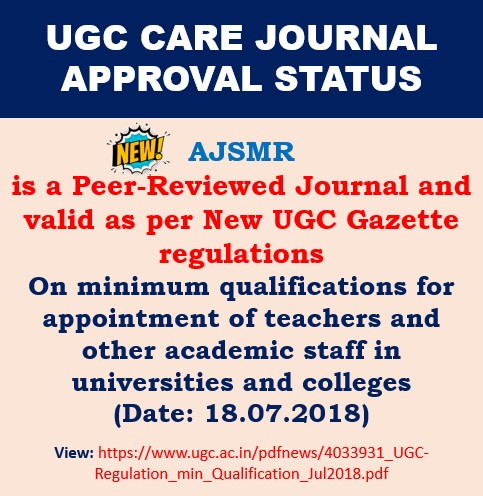Original Research Article I Volume 9 I Issue 2 I 2023
Antimicrobial, Antioxidant and Anticancer Activities of Gold Nanoparticles Synthesized Using Boswellia serrata Aqueous Seed Extract
Ravi Gadepaka; Madhukar Rao Kudle
The American Journal of Science and Medical Research (2023), 9(2); 5-11
DOI:https://doi.org/10.5281/zenodo.8002384
Abstract:
In this paper present study gold nanoparticles (AuNPs) were synthesised using seed extract of Boswellia serrata aqueous seed extracted which is considered as waste material and generally thrown away into the environment. The bioactive molecules in the seed act as reducing agent to synthesise AuNPs without using any external agent. The characterisation of green synthesised gold nanoparticles was done using various spectroscopic techniques. Visual colour change from colour less to ruby red colour confirmed the formation of AuNPs which was further confirmed by optimal density peak at 537 nm by UV-spectra. FTIR analysis confirmed the presence of alcohol, phenol, carboxylic acid, ketones, amines, aromatic amines, aliphatic amines, alkyl halides and alkynes in Boswellia serrata seed which were responsible for the reduction of gold to gold nanoparticles. The green synthesised gold nanoparticles (AuNPs) were evaluated for their antimicrobial, antioxidant and cytotoxic potential. Seeds of boswellia serrata instead of discarding can be successfully utilised for AuNPs synthesis
Keywords:
Boswellia serrata seed powder, Green synthesis, anticancer, antimicrobial, antioxidant, gold nanoparticles extract
References:
- Chanda S, Amrutiya N, Rakholiya K. Evaluation of antioxidantproperties of some Indian vegetable and fruit peels by decoction extraction method. Am J Food Technol. 2013;8(3):173–182.
- Yemis GP,, Bach S, Delaquis P. Antibacterial activity of polyphenol-rich pomegranate peel extract against Cronobactersakazakii. Int JFood Prop. 2019;22(1):985–993.
- Basri HH, Talib RA, Sukor R, et al. Effect of synthesis temperature on the size of ZnO nanoparticles derived from pineapple peel extract and antibacterial activity of ZnO–Starch nanocomposite films. Nanomaterials. 2020;10(6):1061.
- Donga S, Chanda S. Best from waste: therapeutic potential ofplant waste (seeds, peels, flowers). Int J Curr Microbiol Appl Sci.2020;9(08).
- Parvez GMM. Pharmacological activities of mango (Mangiferaind-ica): a review. J Pharmacogn Phytochem. 2016;5(3):1–7.
- Pande J, Chanda S. Screening of anticancer properties of somemedicinal plants–review. Int J Curr Microbiol Appl Sci. 2020;9(3):1348–1362.
- Mohanpuria P, Rana NK, Yadav SK. Biosynthesis of nanoparticles:technological concepts and future applications. J Nanopart Res.2008;10(3):507–517.
- Mukherjee S, Sau S, Madhuri D, et al. Green synthesis and charac-terization of monodispersed gold nanoparticles: toxicity study,delivery of doxorubicin and its bio-distribution in mouse model. JBiomed Nanotechnol. 2016;12(1):165–181.
- Vijayan R, Joseph S, Mathew B. Anticancer, antimicrobial, antioxi-dant, and catalytic activities of green-synthesized silver and goldnanoparticles usingBauhiniapurpurealeaf extract. BioprocessBiosyst Eng. 2019;42(2):305–319.
- Chahardoli A, Karimi N, Sadeghi F, et al. Green approach for syn-thesis of gold nanoparticles fromNigellaarvensisleaf extract andevaluation of their antibacterial, antioxidant, cytotoxicity and cata-lyticactivities.ArtifCellsNanomedBiotechnol.2018;46(3):579–588.
- Perez C, Paul M, Bazerque P. An antibiotic assay by the agarwell diffusion method. Acta Biol Med Exp. 1990; 15:113–115.
- Labieniec M, Gabryelak T. Effects of tannins on Chinese hamstercell line B14. Mutat Res Genet Toxicol Environ Mutagen. 2003;539(1–2):127–135.
- Nagalingam M, Kalpana VN, Rajeswari D, et al. Biosynthesis, char-acterization, and evaluation of bioactivities of leaf extract-medi-atedbiocompatiblegoldnanoparticlesfromAlternantherabettzickiana. Biotechnol Rep . 2018;19:e00268.
- Patra JK, Baek KH. Novel green synthesis of gold nanoparticlesusingCitrulluslanatusrind and investigation of proteasomeinhibitory activity, antibacterial, and antioxidant potential. Int JNanomed. 2015;10:7253–7264.
- K€onen-Adıg€uzel S, Adıg€uzel AO, Ay H, et al. Genotoxic, cytotoxic,antimicrobial and antioxidant properties of gold nanoparticlessynthesized byNocardiasp. GTS18 using response surface meth-odology. Mater Res Express. 2018;5(11):115402.
- Barai AC, Paul K, Dey A, et al. Green synthesis ofNeriumoleander-conjugated gold nanoparticles and study of itsinvitroanticanceractivity on MCF-7 cell lines and catalytic activity. Nano Converg.2018;5(1):1–9.
- Singh P, Pandit S, Garnaes J, et al. Green synthesis of gold and sil-ver nanoparticles fromCannabissativa(industrial hemp) and theircapacity for biofilm inhibition. Int J Nanomed. 2018;13:3571–3591.
- Gahlawat G, Choudhury AR. A review on the biosynthesis of metaland metal salt nanoparticles by microbes. RSC Adv. 2019;9(23):12944–12967.
- Markus J, Wang D, Kim YJ, et al. Biosynthesis, characterization,and bioactivities evaluation of silver and gold nanoparticles medi-ated by the roots of Chinese herbalAngelicapubescensMaxim.Nanoscale Res Lett. 2017;12(1):46.
- Rajan A, Vilas V, Philip D. Studies on catalytic, antioxidant, anti-bacterial and anticancer activities of biogenic gold nanoparticles.J Mol Liquid. 2015;212:331–339.
- Allen RT, Hunter WJ, Agrawal DK. Morphological and biochemicalcharacterization and analysis of apoptosis. J Pharmacol ToxicolMethod. 1997;37(4):215–228.
- Poojari, S., Porika, R., & Mamidala, E. (2014). Phytochemical analysis and in vitro antidiabetic activities of Physalis angulata fruit extracts. Natl. J. Integr. Res. Med, 5, 34-38.
Article Dates:
Received: 25 April 2023; Accepted: 30 May, 2023; Published: 4 June,, 2023
How To Cite:
Ravi Gadepaka, & Madhukar Rao Kudle. (2023). Antimicrobial, Antioxidant and Anticancer Activities of Gold Nanoparticles Synthesized Using Boswellia serrata Aqueous Seed Extract. The American Journal of Science and Medical Research, 9(2), 5–11. https://doi.org/10.5281/zenodo.8002384



